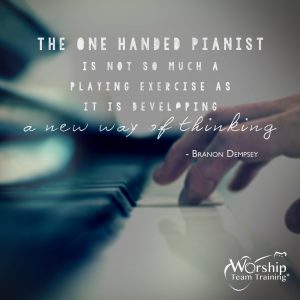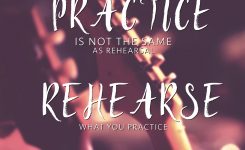Keyboard, Piano, Players
The One Handed Pianist
 #PlaySkillfully (Music Lesson Video)
#PlaySkillfully (Music Lesson Video)
The quality of a musician comes down to the care of their craft. Making music great unto the Lord is worthy of His praise, but if we are just making music without the love of Christ in our hearts, we are just making noise. Most often pianist tend to think in terms of hands and clefs.
This would be bass and treble clef, left and right hand. When playing with the band, they come to a fork in the road. They try to play in both hands, without realizing it, they take up all the musical space.
The best way for pianist to contribute to the band is to compliment the group, rather than being the one man band. How can this happen? This is one of the topics we cover in our Weekend Workshops: “where does the piano play?” it’s not exactly what to play, but how and when. We cover three basic things: listening, visualizing and adapting.
Listen
The average pianist in the worship band turns out to be one of the greatest musicians. The fact is, they are great in many unique ways that may differ from others. Pianists who simply play by sight reading and not by ear, experience the challenge in playing with a band.
Same is true for those who play by ear; their challenge could be playing by the chart or sheet music. The one common thing that both players have as an ace-in-the-hole is their ability to understand all the parts. Also, they are musical machines that can easily be tamed tigers. Mark 4:9 Then Jesus said, “Whoever has ears to hear, let them hear.” Pianists have a great sense of what’s happening in the song.
They can easily follow the ranges in the bass, and ranges in the lead guitar parts because it relates to bass and melody. By listening, you can hear the movement of the different instruments. The pianist has the opportunity to break down the parts of the band. They may not understand entirely how to play a guitar, but they can easily follow how the parts are coming together.
The trick is you don’t have to play every part of the band, all you need to do is listen. @branondempsey
Visualize
This may be helpful for pianist that don’t know what to play in a band. But how can pianists make music when they can’t make out what to play? Simplify. Proverbs 4.25 “Let your eyes look straight ahead; fix your gaze directly before you.” When musicians hear music, their muscle memory kicks in.
Their dexterity takes over and their hands fingers and feet begin to move. It’s like hearing your favorite song and all of the sudden your foot begins to tap. When working with pianists, I encourage them to first listen, feel then see the music. When they begin to hear what’s happening, I try to help them tap into the song’s emotion: the tone, drive and dynamic. Most pianists have a very good sense of these skills. They use them daily in their regular playing.
Next, we begin to move from what is being heard/felt into what can be seen. I begin to ask them questions like: how are they seeing things musically come together? Can they see themselves playing in the music? Can they visualize the right and wrong choices based on what they are hearing?
At this point, we are trying to help the pianist develop self-awareness. The better they can understand what’s happening around them by hearing and seeing, they will have a sharper idea of who to adapt. “Everyone kept feeling a sense of awe; and many wonders and signs were taking place through the apostles.” Acts 2.43
Adaptation
The approach of the instrument makes all the difference in the music. By the way we interpret a piece of music we are able to adapt to the music’s needs. If the song is slow and at a low dynamic level, we would not want to hammer out stark chords at fast rhythms. Same is true for fast songs, if we play to low or to subtle, the piano would be non-existent. Use what you have in the song and adapt.
Let’s say we are playing in 4/4, medium tempo to a pop style tune. Pick any key. Things to help pianists focus on number one is the bass pattern. Help them listen to the movement and see if they can visualize (not playing) doing the same thing in their left hand. Next, hone in on what the drummer is doing by keeping time.
What pattern are they playing in? Is the hi-hat playing in 4’s, 8th’s or 16th’s? Also, where is the snare being placed on the back beat: 2 and 4, or maybe on just count 3. The bass and drums set the primary groove, the pianist’s job is to fill in the gap.
This doesn’t mean to play in every given open space. Actually, they are to do the opposite: find every present gap and help widen it. How does this happen? Play less than what you would really play. Try playing less than half, maybe a quarter.
Try One Hand
This is a very difficult exercise for most pianists because they are so used to playing everything and everywhere. By playing with one hand, they are forced to do the top following: listen, look and feel.
Play in the middle register. Because the bass is far left and the guitars/higher pitched instruments are far right, the piano can sit in the middle. When piano players are faced with this limitation, they are forced to play less. Where the magic happens is all the music they hear. Now they are learning how to play more by ear and less by chart. When your head is buried in the music, it’s hard to experience what the rest of the band is feeling.
By playing with one hand, the key is to take in what you hear and respond through simplicity. It’s complimenting, supporting and comping. This still doesn’t answer: “what should they exactly play?” This will look different for every song. There’s no one-way to play each tune. You must develop a good ear and vision for the music.
Then, apply it accordingly to each tune. Practice by the mp3. I have singers do this all the time. Listen to the music, play/sing a few notes at a time. Don’t play over all the parts. Just take your time, listen and adapt to what’s being heard. Try this also, playing with one hand. It will be challenging at first, but the idea is to produce patience. Again, self awareness.
The one handed pianist is not so much a playing exercise as it is developing a new way of thinking. Good musicians listen all the time, in fact they may only play 30% of the time. There is so much happening around the band that they begin to play in parts. Your band will sound cleaner, better and more spacious when they think and play in parts. The one-handed method can be applied to drummers, bassists and other guitar players. The simple rule: less is truly more. We may be independent instrumentalists, but we are interdependent as a team. “The eye cannot say to the hand, “I don’t need you!” And the head cannot say to the feet, “I don’t need you!” 1 Cor12.21
@BranonDempsey @worshiptt 
Worship Team Training® Is your worship team stuck? Want worship leading to be better? Want to be free? We can take you there. Inspire, create and transform the leading of worship. Get a WeekendWorkshop Copyright 2017 Worship Team Training®










2 Comments
Terry Davis
Good stuff…
One thing I do need is finding a way to run a more efficient rehearsal with musicians at our church. Instead of having our guys come to choir rehearsal on Thursday, they come out on Saturday, an hour before our worship leaders rehearse.
One of the things that kinda hinders me is having to lead the band when one isn’t sure of the material. Should I stress to all to listen to the material more? Sometimes when our choir is singing, and I want to get up to direct, I can’t because our other keyboard player isn’t sure of a song. They’re usually fine when we get to a “vamp” or repeat section of a song.
Any suggestions offered would be greatly appreciated!
branondempsey (Author)
Yes TD! Thanks for writing/asking! Yes, it is to be stressed for musicians (and singers) to come prepared. Isn’t this true for other ministries in the Church? Making guidelines would be helpful – if you don’t know your parts, sit out on the tune. No practice / no play policies are hard to enforce, but depending on your pastor/leadership, I would defer their call. One thing you can try is to give better parts to those who prepare. Rotate the committed musicians more regularly. Come along side the lesser inclined musicians after rehearsal or during the week to help them. Overall, your team is worth shepherding and guiding – every person matters.